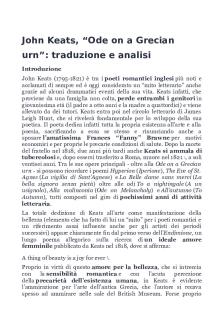Keats research context PDF

| Title | Keats research context |
|---|---|
| Course | English: Standard English |
| Institution | Higher School Certificate (New South Wales) |
| Pages | 2 |
| File Size | 39.7 KB |
| File Type | |
| Total Downloads | 94 |
| Total Views | 141 |
Summary
Keats research context...
Description
Personal context of John Keats - Romantic poet - Trained initially to be a doctor, but gave up his education to become a poet - He experienced many deaths since he was young (death of father, mother, then brother, all to tuberculosis) → triggered his fear of premature death and deep desire to leave a legacy - Negative capability: the ability to p ursue a vision of artistic beauty even when it leads them into intellectual confusion and uncertainty - He was greatly influenced by Wordsworth (1st gen), and consequently followed Wordsworthian celebration of the natural world and an innate love of life Historical and literary context - keats poems - Romantic era (late 18th, early 19th): romanticism was a shift from classicism; a dominant movement in literature and art, a reaction against the enlightenment period and Augustan age, where order, harmony and objectivity were preferred, and response to the industrial revolution and French revolution; contrast to neoclassical era. - Pantheism and focus on power of nature (almost religiously) where it should not be perceived scientifically but as a living force instead of a tool for man (rejects industrialism) - Emphasis on imagination as a positive and creative faculty - A new capacity for wonder and pull to the innocence of the vision of childhood - Lives of marginalised and outcasts of society (beggars, tramps & the poor and disregarded) - More focus on the individual and importance of self-expression and individual feeling - the poet’s perceptions and feelings mattered most & more emotional and imaginative spontaneity rather than reason - Significant contemporary poets included: William Blake (pre-romantic), William Wordsworth (1st gen), Percy Shelley (2nd gen) - His poetry conveyed: - His emphasis on bodies, blushing, the sensuous and sensual (perceived to be a more feminist trait in poetry) - The sense that we are completely physical in a physical world - The allied realisation that we are compelled to imagine more than we can know or understand - Negative capability: the ability of writers to contemplate the world without the desire to try and reconcile contradictory aspects or fit it into closed and rational systems Historical and literary context - bright star (film) - A contemporary film (2009) - Focuses on John Keats and Fanny Brawne’s relationship through Fanny’s perspective in his last three years of life
-
-
And viewing him and his issues through his lovers perspective humanises john keats from just the disembodied poet seen through his poems creates a more intimate connection with the audience - Symbolises contemporary emphasis on the female over males and their increasing dominance in society of the 21st century, empowering women - Acknowledgement of females personal voice and emotions that was disregarded in Keats’s time - This is reinforced by the numerous shots that revolve around Toots - Her feminist views are likewise shared in “the piano”, “Top of the Lake: China Girl” However reflects the Romantic focus on sensual imagery: focuses on hands and intense emotions; moves from shots indoors gradually to outdoors (nature) as the relationship develops (elevation of nature)
Key themes - pain/pleasure - Dream or vision/reality - joy/melancholy - The ideal/the real - mortal/ immortal - Fear of mortality/death and immortality - life/death - separation/connection - Being immersed in passion/Desiring to escape passion - Power of imagination and the sublime beauty/value of divine nature - Exploration of keats’s emotions...
Similar Free PDFs

Keats research context
- 2 Pages

John Keats, Summary
- 2 Pages

Keats V Campion quotes
- 4 Pages

Campion and keats comparative
- 3 Pages

Context webcode context-15
- 7 Pages

Nisar Ahmed ( Keats Assignment )
- 3 Pages

QUIZ on Keats Week 1
- 9 Pages

ODE TO Autumn - John Keats
- 5 Pages

John Keats-Ode on a Grecian Urn
- 10 Pages

Institutional Context
- 1 Pages

Presentation Context
- 1 Pages

Dracula - context
- 1 Pages

Context Final
- 3 Pages

multimedia context
- 5 Pages
Popular Institutions
- Tinajero National High School - Annex
- Politeknik Caltex Riau
- Yokohama City University
- SGT University
- University of Al-Qadisiyah
- Divine Word College of Vigan
- Techniek College Rotterdam
- Universidade de Santiago
- Universiti Teknologi MARA Cawangan Johor Kampus Pasir Gudang
- Poltekkes Kemenkes Yogyakarta
- Baguio City National High School
- Colegio san marcos
- preparatoria uno
- Centro de Bachillerato Tecnológico Industrial y de Servicios No. 107
- Dalian Maritime University
- Quang Trung Secondary School
- Colegio Tecnológico en Informática
- Corporación Regional de Educación Superior
- Grupo CEDVA
- Dar Al Uloom University
- Centro de Estudios Preuniversitarios de la Universidad Nacional de Ingeniería
- 上智大学
- Aakash International School, Nuna Majara
- San Felipe Neri Catholic School
- Kang Chiao International School - New Taipei City
- Misamis Occidental National High School
- Institución Educativa Escuela Normal Juan Ladrilleros
- Kolehiyo ng Pantukan
- Batanes State College
- Instituto Continental
- Sekolah Menengah Kejuruan Kesehatan Kaltara (Tarakan)
- Colegio de La Inmaculada Concepcion - Cebu

